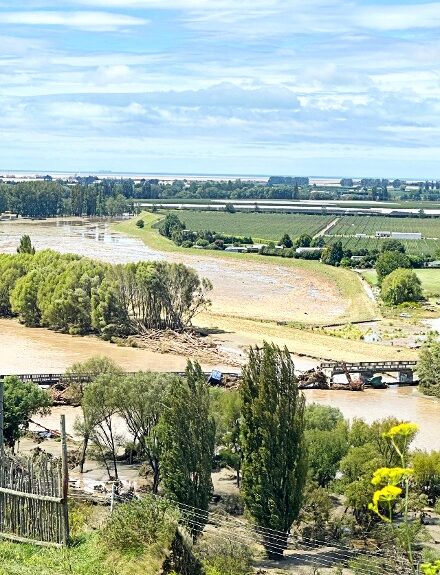Cyclone Gabrielle is New Zealand’s most significant weather event this century, causing severe flooding and landslides across the North Island.
It washed out utilities, inundated roads, and destroyed at least six bridges across the east coast and Hawke’s Bay. The storm has killed eleven people as of writing this blog post.
The amount of property and infrastructure damage it wrought, which officials say could exceed NZ$13.5 billion, was almost similar to the cost of rebuilding Christchurch after the earthquake in 2011, says Finance Minister Grant Robertson (Craymer, 2023).
Prime Minister Chris Hipkins says the severity of damage the storm caused has not been experienced in a generation.
Weeks after cyclone Gabrielle ravaged large parts of the North Island, Hawke’s Bay and Gisborne, and Wairoa, a coastal town in Hawke’s Bay and Gisborne, is once again under flood waters forcing residents to evacuate (Franks, 2023).
With climate change predicted to make extreme weather events more frequent and intense, causing direct damage to infrastructure and properties at sobering costs, experts and academics from New Zealand universities gave their thoughts on the country can reduce infrastructure damage and at what point will communities most affected by the cyclone consider relocating.
Below are excerpts from BBB experts’ interviews.
Professor Regan Potangaroa, Professor of Resilient and Sustainable Built Environment (Maori Engagement) at Massey University, says:
“It is important to prioritise resilience in designing and constructing new infrastructure. This means considering the potential impacts of extreme weather events, such as flooding and landslides, and building infrastructure that can withstand these conditions. Additionally, regular maintenance and inspections can help identify and address issues before they become major problems.”
When it comes to deciding to relocate or implement managed retreat, Prof Potangaroa states that decisions should not just be based solely on cost benefit-analysis and short-term economic gains but should take a holistic approach by considering the long-term well-being of residents and the broader impacts on their health, needs, and safety.
Sandeeka Mannakkara, Lecturer, Department of Civil and Environmental Engineering, University of Auckland:
“It is high time that we as a country move away from reactive responses to natural hazard events and adopt a proactive approach to break away from the post-event “repair and rebuild” cycle. Proactive management of infrastructure requires a commitment to understanding updated risk levels as per climate change projection models, thoroughly reviewing the ability of our lifelines infrastructure to cope, and putting the necessary resources in place to upgrade vulnerable infrastructure and innovate.”
Dr Mannakkara says that building back better to improve resilience does not merely rely on the built environment to prevent or minimise risks. True resilience takes a holistic approach “through changes to land use, implementing effective early warning and disaster risk reduction education of stakeholders and communities, enhancing social and economic resilience of communities, and having institutional mechanisms, legislation, and monitoring and evaluation in place that supports these activities.”
Professor Suzanne Wilkinson, College of Sciences, Massey University, says,
“To improve climate resilience, we need to stop rebuilding in unsuitable places. If we do build in those places, we need to change how we build and incorporate higher resilient features (using better materials or different parameters). We need to build above code and take a multi-hazard, intergenerational approach.”
Professor John Tookey, School of Future Environments, AUT, says the demand for more infrastructure is always there. In rural areas with smaller populations, the investments are disproportionately high compared to bigger cities. Because infrastructures are costly, they are expected to last for a long time. Patch, repair, and upgrade are commonly used to lengthen its life, and replacement is the absolute last resort only when patching, replacing, and upgrading is no longer possible, or the costs would be close to replacing the infrastructure, he says.
For Prof Tookey, the future infrastructure in rural areas would be to lessen the rural areas’ dependence on costly horizontal infrastructure like power lines that stretch for miles. Instead, rural areas need to invest in local power generation powered by renewables, insulating houses to reduce power consumption, using satellite-based internet and improving phone services so that operations can continue if roads get damaged, subsiding grey water holding tanks to reduce pressures off stormwater systems.
Read the entire article:
Source:
Craymer, L. (2023 February 21). New Zealand says cyclone damage could exceed $8 billion. Reuters. Retrieved from https://www.reuters.com/world/asia-pacific/nz-police-reach-more-people-previously-not-contactable-after-cyclone-gabrielle-2023-02-19
Building back better after Cyclone Gabrielle – Expert Reaction. (2023, February 16). Science Media Centre. Retrieved from https://www.sciencemediacentre.co.nz/2023/02/16/building-back-better-after-cyclone-gabrielle-expert-reaction/
Franks, R. (2023, February 28). Mangapapa, Gisborne residents evacuated by severe flooding, section of SH 5 slips away. NZ Herald. Retrieved from https://www.nzherald.co.nz/nz/new-tropical-cyclone-judy-looms-as-north-island-grapples-with-more-heavy-rain



Leave a Reply